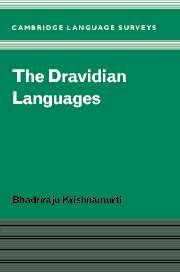Book contents
- Frontmatter
- Contents
- List of illustrations
- List of tables
- Preface
- Acknowledgements
- Note on transliteration and symbols
- List of abbreviations
- 1 Introduction
- 2 Phonology: descriptive
- 3 The writing systems of the major literary languages
- 4 Phonology: historical and comparative
- 5 Word formation: roots, stems, formatives, derivational suffixes and nominal compounds
- 6 Nominals: nouns, pronouns, numerals and time and place adverbs
- 7 The verb
- 8 Adjectives, adverbs and clitics
- 9 Syntax
- 10 Lexicon
- 11 Conclusion: a summary and overview
- Bibliography
- Index of reconstructions with glosses
- General index
6 - Nominals: nouns, pronouns, numerals and time and place adverbs
Published online by Cambridge University Press: 22 September 2009
- Frontmatter
- Contents
- List of illustrations
- List of tables
- Preface
- Acknowledgements
- Note on transliteration and symbols
- List of abbreviations
- 1 Introduction
- 2 Phonology: descriptive
- 3 The writing systems of the major literary languages
- 4 Phonology: historical and comparative
- 5 Word formation: roots, stems, formatives, derivational suffixes and nominal compounds
- 6 Nominals: nouns, pronouns, numerals and time and place adverbs
- 7 The verb
- 8 Adjectives, adverbs and clitics
- 9 Syntax
- 10 Lexicon
- 11 Conclusion: a summary and overview
- Bibliography
- Index of reconstructions with glosses
- General index
Summary
Introduction
Nominals in Dravidian are a morphosyntactic class of words, which are inflected for case. Nominals consist of four subclasses: nouns, pronouns, numerals and adverbs of time and place. All but the adverbs are distinguished for gender and number, besides being inflected for case. Adverbs of time and place are morphologically nominal, since they carry case suffixes, but syntactically they function as adverbs, i.e. modifiers of the verb.
Noun stems can be simple, complex or compound. Simple stems are identical with the roots, e.g. *kāl ‘leg’, *ūr ‘village’. Complex stems result from the addition of derivational morphemes to verbal, adjectival, or nominal roots, e.g. *wil-ay ‘price’ from *wil ‘to sell’ (see section 5.8.1a), *weḷḷ-ay, *weḷ-u-ppu, *weṇ-may ‘whiteness’ from *weḷ / *weṇ ‘white’ [5496]. Compound stems consist of a minimum of two roots of which the head is a noun and the satellite a noun, an adjective or a verb, e.g. *kaṇ-ṇīr ‘tear’ (N + N), lit. ‘eye-water’ [1159b], *kiṯṯ-eli ‘a mouse’ (adj + N) (lit. ‘small rat’) [1594].
Gender and number: identification and definition
Gender is a system of classifying ‘nouns’ (other than time and place adverbs) in terms of certain semantic and formal properties, supported by their grammatical behaviour. In Dravidian, gender is distinguished in terms of the semantic categories [± human], [± male human], and marginally [± animate].
- Type
- Chapter
- Information
- The Dravidian Languages , pp. 205 - 276Publisher: Cambridge University PressPrint publication year: 2003



